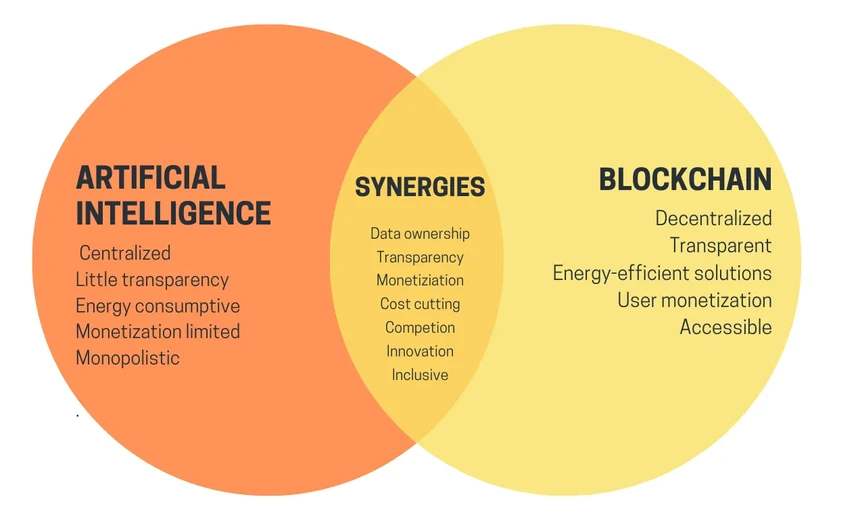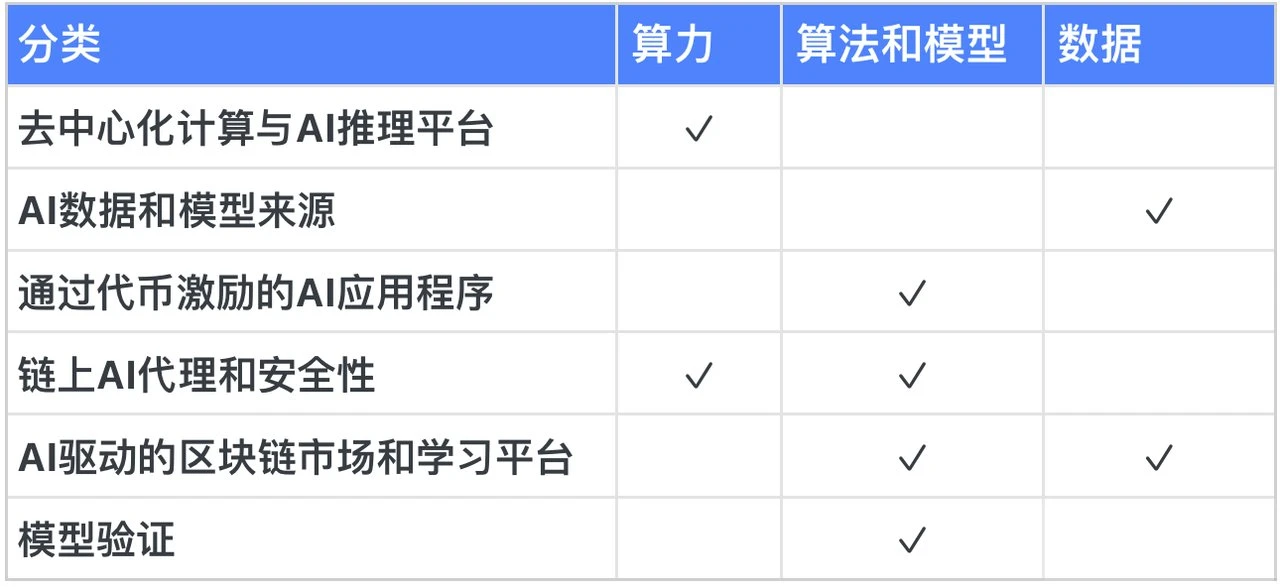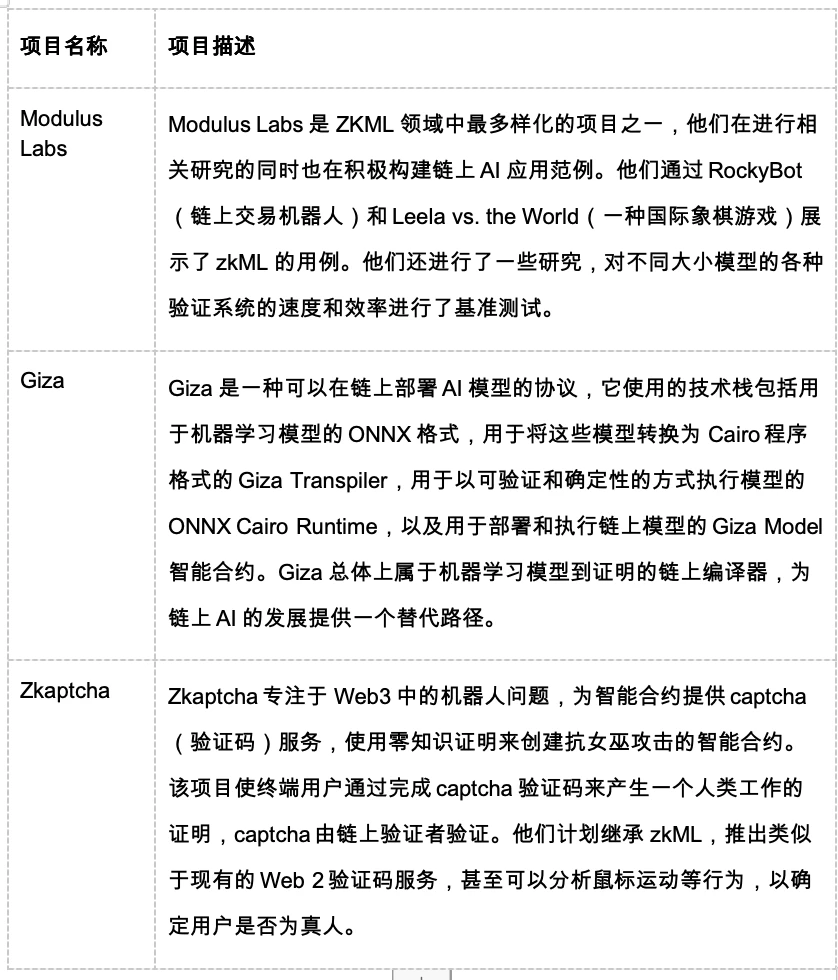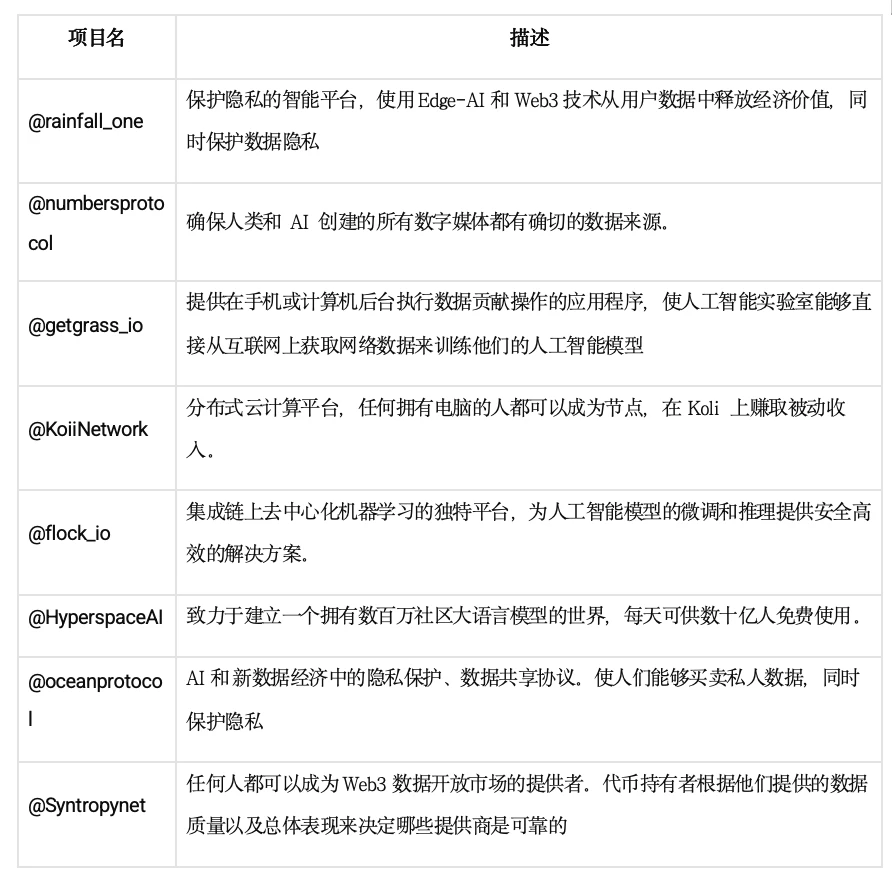HTX Ventures Research Report: Exploring Investment Directions in the AI+Crypto Track
In recent years, with the rapid development of artificial intelligence (AI) and blockchain technology, the AI+Crypto track has become a hot area for investors. Blockchain, with its decentralization, high transparency, low energy consumption and anti-monopoly characteristics, makes up for the strong centralization and opaque processing of AI systems. The combination of the two has brought us unprecedented opportunities.
According to Vitalik, the combined application of AI and blockchain can be divided into four categories: as an application participant, as an application interface, as an application rule, and as an application target. He proposed that the role of AI in Crypto should be considered more from the perspective of application, including optimizing computing power, optimizing algorithms, and optimizing data.
Huobi Research Institute distinguishes the direction of Crypto technology participation according to the application level of AI, which can be divided into the basic layer, execution layer and application layer. There are opportunities worth exploring at each level. For example, zkML technology combines zero-knowledge proof and blockchain technology to provide a secure, verifiable and transparent solution for AI agent behavior. In addition, AI has also shown great potential in the execution level such as data processing, automated dApp development, and on-chain transaction security. At the application level, AI-driven trading robots, predictive analysis tools, and AMM liquidity management play an important role in the DeFi field.
This article will discuss in detail the investment direction of the AI+Crypto track, focusing on innovation and development at the infrastructure and application levels, and analyzing the prospects and challenges of the combination of AI and blockchain from the perspective of mid-term and long-term investment strategies.
This article was written by Huobi Research, a team currently affiliated with HTX Ventures. HTX Ventures is the global investment arm of Huobi HTX, integrating investment, incubation and research to identify the best and most promising teams in the world. Currently, HTX Ventures has supported more than 200 projects across multiple blockchain tracks, some of which have been listed on Huobi HTX trading.
Key areas of AI track
Blockchain is completely opposite to artificial intelligence in terms of centralization, low transparency, energy consumption, and monopoly. According to the above criteria and his own thinking, Vitalik divides the applications of combining artificial intelligence and blockchain into 4 categories:
-
AI as a player in a game
-
AI as an interface to the game
-
AI as the rules of the game
-
AI as the objective of the game
Vitalik Buterin considers the role of AI in Crypto more from the perspective of application. If we consider it from the perspective of productivity VS production relations, Crypto actually provides more production relations. From this point of view, we can consider it from three main directions:
– Optimize computing power: Provide decentralized and efficient computing resources, reduce the risk of single point failure, and improve overall computing efficiency.
– Optimization algorithms: Promote open source, sharing and innovation of algorithms or models.
– Optimize data: decentralized storage, contribution, use and secure management of data
HTX Research believes that the overall direction of AI can be divided into the basic layer, execution layer and application layer according to the general architecture. Correspondingly, we can also explore AI+Web3 projects from these three major directions. At the basic layer, including model training, data, decentralized computing power and hardware at the infrastructure level, focus on the combination of zk technology and artificial intelligence ML technology; at the execution layer, data processing and data transmission, AI agent, zkML, FHE (fully homomorphic encryption) at the model level; at the application layer, it mainly focuses on AI+DeFi, AI+GameFi, Metaverse, AIGC and Meme, as well as RAAS (Robotics as a Service), oracles, coprocessors, UBI (universal basic income) at the blockchain level.
Among them, projects at the infrastructure and application levels are developing rapidly, such as Io.net at the computing power level, Flock at the basic model level, ZeroGravity, the blockchain infrastructure, Myshell, the AI agent, and 0x Scope at the application level.
The following directions can be explored:
1. zkML Direction
zkML technology combines zero-knowledge proofs and blockchain technology to provide a secure, verifiable, and transparent solution for monitoring and constraining the behavior of AI agents. For example, the Modulus Labs project uses zkML technology to prove to stakeholders that its AI has performed specific tasks while protecting personal privacy and business secrets.
zkML, as an intermediary between artificial intelligence and blockchain, proposes a set of solutions to solve the privacy protection issues of AI models and inputs, and ensure the verifiability of the reasoning process. It creates a new way to use public models when verifying private data, or use public data when verifying private models. By integrating the power of machine learning, smart contracts can achieve more autonomy and dynamism, and can operate based on real-time on-chain data rather than just static rules. This innovation makes smart contracts more flexible and able to adapt to more different application scenarios, even those that were not foreseen when the contract was originally set up.
Introduction to typical zkML technology projects
The first table is an introduction to some potential ZKML projects. The second picture shows some other ZKML projects.
2. Data processing direction
It mainly refers to various breakthroughs in AI at the execution level, especially some breakthroughs in blockchain data transmission and development. The specific analysis is as follows:
a. AI and on-chain data analysis
This direction mainly refers to using AI technology to deeply mine these data, and using LLM large models and deep learning algorithms to gain more insights. For example, the Web3 Analytics project uses AI to analyze on-chain data to reveal market trends and user behaviors. It can help users gain insights into on-chain transactions and market trends.
b. AI and automated dApp development
This direction is mainly aimed at some infrastructure projects of DevOps. Some AI projects that use automated development can take on more developers, making the ecosystem more prosperous. Some development tools that use AI can also help developers write smart contracts more quickly and automatically correct errors, and some can also implement drag-and-drop DAPP programming functions.
c. AI and on-chain transaction security
This direction mainly refers to AI agents. It involves deploying AI agents on the blockchain to improve the security and credibility of AI applications. These AI agents can automatically perform tasks such as transactions, data analysis, automatic decision making, etc., and being deployed on the blockchain makes their operations not only transparent and traceable, but also difficult to be tampered with, improving the security of the entire system. AI technology can identify and defend against malicious attacks and data leaks through real-time monitoring and intelligent analysis, ensuring the security of transactions and the integrity of data.
• Project cases:
SeQure is a security platform that uses AI for real-time monitoring and analysis to promptly detect and defend against various malicious attacks and data leaks, ensuring the stability and security of on-chain transactions.
3. AI+DEFI direction
The most important combination of AI and the application layer is AI+DEFI. Here are some AI+DEFI directions to pay attention to:
1. AI-driven trading robots
These robots are able to execute trades quickly and accurately, analyzing market data, news sentiment and price trends to make split-second trading decisions, often outperforming human traders.
2. Predictive Analytics
While predicting crypto market volatility has always been a challenge, AI-powered analytics tools are emerging as an important tool that can provide reliable predictions of market trends and potential price movements.
3. AMM Liquidity Management
For example, when adjusting the liquidity range of Uniswap V3, through the integration of AI, the protocol can adjust the liquidity range more intelligently, thereby optimizing the efficiency and benefits of the automated market maker (AMM).
4. Liquidation protection and debt position management
Combining on-chain and off-chain data allows for more intelligent implementation of liquidation protection strategies, ensuring that debt positions are protected during market fluctuations.
5. Complex DeFi structured product design
When designing treasury mechanisms, you can rely on financial AI models rather than fixed strategies. Such strategies may include AI-managed transactions, loans, or options, which increase the intelligence and flexibility of the product.
4. AI+GameFi direction
The application of AI in the GameFi project is mainly to enrich the gaming experience and increase the possibility of innovation. Its main directions are as follows:
1. Game strategy optimization:
AI can learn from players gaming habits and strategies, adjust the difficulty and strategy of the game in real time, and provide a more personalized and challenging gaming experience. Through deep learning and reinforcement learning, AI can evolve itself and better adapt to players needs and preferences.
2. Game asset utilization management:
AI technology can help players manage and trade virtual assets in games more efficiently. Using smart contracts and automated trading strategies, players can maximize the use of assets, for example, automatically buy, sell, lease and lend game assets, thereby optimizing returns on investment.
3. Enhance game interaction:
AI can create more intelligent and responsive non-player characters (NPCs), and through natural language processing (NLP) and machine learning (ML) technologies, achieve more natural and smooth interactions with players, thereby improving game immersion and player satisfaction.
Possible investment strategies from a time perspective
– In the short term, we should pay attention to the areas where AI first landed in Crypto, such as some conceptual AI applications and memes. Logic: This year, the mainstream AI circle will continue to output new hot spots. Every time a large model of web2 companies such as NVIDIA and OpenAI is upgraded, it will ignite the hot spots of the AI track, and it will also bring in new funds. These are all the emotional aspects of this track.
– In the medium term, the combination of Ai Agent and Intent, and the combination with smart contracts is a highlight. Once AI is successful, it will provide a solution for the expansion of smart contracts, thus forming a new blockchain of ledger + contract + AI, breaking through the ledger + contract narrative of the ETH era.
– AI Agent is a subdivision that Vitalik has mentioned. AI Agent refers to an AI agent that can autonomously obtain information from the environment, process information, make decisions, execute, and change the environment. AI Agent is currently a cutting-edge subdivision in the field of AI and is the application layer closest to Mass Adoption.
– From a narrative perspective. AI Agent is a sexy beauty, GPU cloud computing power is a stable and mature middle-aged entrepreneur, and the AI model combined with the DA layer is a scientist with messy hair.
– In the long run, the combination of AI and zkML technology (although the ML bosses of web2 AI companies scoff at Cryptos use of AI) will ultimately affect the Crypto field.
references
– Twitter: https://twitter.com/FinanceYF5/status/1772434625387717055
-Web3 Caff: https://twitter.com/Web3 Caff_Res
– Twitter Vitalik: https://twitter.com/VitalikButerin
appendix:
List of decentralized computing and AI reasoning platform projects
It mainly refers to the use of Crypto as an incentive to share and utilize idle computing resources on a global scale.
List of AI data and model source projects
This part is mainly based on the authenticity, transparency and traceability of the data, and uses the Crypto economic model to provide data incentives (for C-end users) and model incentives (Dev, B-end).
This article is sourced from the internet: HTX Ventures Research Report: Exploring Investment Directions in the AI+Crypto Track
Original author: Duncan Original translation: TechFlow While Rune is stealing the show, Bitcoin developers are hard at work introducing a Frankenstein-like monster on top of the world’s most trusted blockchain. Because Bitcoin can take so many different forms, you might think of Bitcoin’s second layer as more of a venture capital gimmick than a cutting-edge development in finance. But, dear reader, please note that Bitcoin is much more than people think. Example? Okay. Bitcoin is like an onion with many layers. In the current case of Bitcoin, there is L2, an emerging narrative that promises to bring Bitcoin into decentralized finance, providing people with lucrative returns. But, like an onion, there are different kinds, and how they are prepared is important. Will the high-end technology attract new users, or just…













